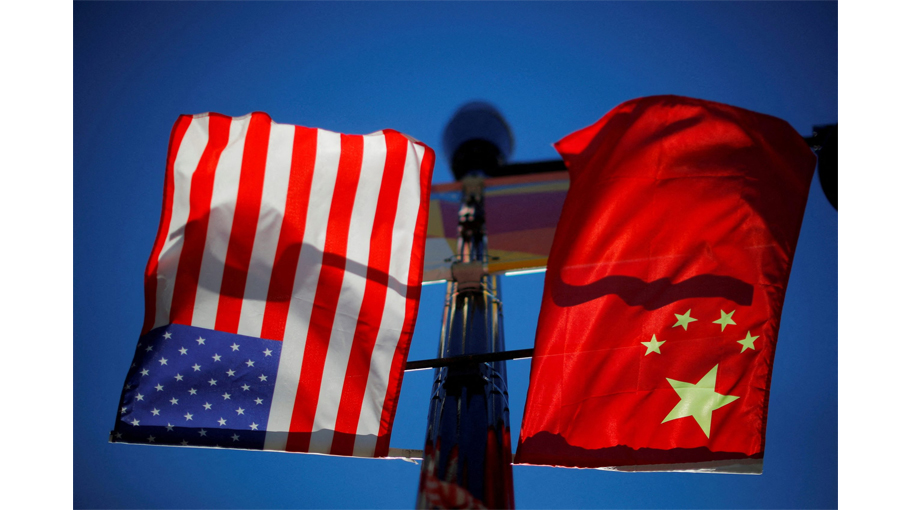The United States and China’s complex cooperation and rivalry continue

The world has witnessed a complex tapestry of economic and technological dynamics between the United States and China, with 2023 marking a period of continued economic interdependence and technostrategic rivalry.
Despite a nominal dip in US imports from China, bilateral trade volumes remained substantial. US exports to China totalled US$135.8 billion and imports stood at US$393.1 billion for January–November 2023.
Trade represents only a facet of the economic bond between the United States and China. Policymakers, cognisant of the perils inherent in economic decoupling, have started to eschew such a course. High-level meetings and initiatives, like the US–China economic and financial working groups established in September 2023, offered a positive glimpse of potential bilateral relations. A meeting between US President Joe Biden and Chinese President Xi Jinping in November 2023 highlighted China’s willingness to partner with the United States.
In contrast, the high-tech landscape in 2023 was tense. The United States reinforced its global stance against China’s ascendancy, supported by US political parties. In response to escalating external pressure, terms like ‘struggle’ and ‘fight’ resurfaced in China’s strategic discourse. Key issues such as the ongoing tariff war and stringent export controls on critical technologies continued to underscore the intense rivalry between the world’s two superpowers.
Moving into 2024, the US–China economic and technological relations are poised to undergo a shift, characterised by enhanced communication, selective cooperation and balanced management of both interdependence and competition.
There is a mutual understanding among senior officials of the potentially devastating repercussions associated with misunderstandings and miscalculations in the US–China relationship. 2024 is expected to witness increased economic dialogues between Beijing and Washington.
US Treasury Secretary Janet Yellen, speaking at the US-China Business Council on 14 December 2023, expressed the intention to reinforce communication channels, intending to build resilience in dialogue to avert escalation from disagreements and unforeseen events. Similarly, Chinese commerce officials are preparing for an inaugural vice-ministerial meeting in early 2024 to better comprehend US strategies and concerns while also conveying China’s commitment to maintaining robust bilateral economic ties.
US–China commercial cooperation will likely pivot towards climate finance and financial markets. Joint endeavours in climate finance have the potential to elevate both countries as frontrunners in mitigating climate-related risks. Cooperation in financial markets could bolster economic stability for both countries.
China is expected to further open its market to attract US businesses and investment amid global economic uncertainties, alleviating trade tensions and promoting a more cooperative economic milieu. In 2024, Chinese local governments will likely continue to improve their treatment towards foreign firms — including US companies — particularly in government procurement, bidding processes and the establishment of industry standards.
2024 will witness intensified technological competition. National security concerns will continue to drive fierce competition between the two superpowers. The US government is likely to escalate its pressure on China, especially in the high-tech sector.
Both political parties in the United States will have a sharp focus on China policy due to the 2024 presidential election. A tougher stance to counter China’s growing strategic high-tech industry is expected to be a significant part of the political narrative, reflecting the strategic importance and sensitivities surrounding this area. It is possible that more voices in the United States may call to revoke the Permanent Normal Trade Relations with China, in the hopes of reversing the decline in US manufacturing.
On the Chinese side, industrial policy is poised to gain momentum in the broader context of a strategic tug-of-war, where an increasing number of countries, including the United States, are strengthening state intervention and vying for global technological competitiveness. Domestically, Chinese policymakers plan to leverage industrial policies to ascend the value chain and sustain economic growth.
Beijing will adopt an active fiscal policy in 2024, increasing government expenditure and focusing resources on major initiatives. In the beginning of 2024, over a dozen provinces and cities announced ambitious plans to issue special bonds to support massive investment in new generation information technology, biopharmaceuticals and artificial intelligence.
The US–China economic interdependence is likely to persist in 2024. To mitigate potential economic friction with the United States and buttress China’s exports, Chinese policymakers will further strategise in Southeast Asia, the Middle East, Latin America and Africa. China will continue strengthening and expanding commercial exchanges with countries involved in the Belt and Road Initiative. This transition signifies a shift from a ‘reactive’ to a ‘proactive’ global approach.
2024 is destined to be another eventful year for China and the United States, shaped by a multitude of domestic and systemic factors. The trajectory of the US–China economic and technological relations will have consequential impacts on the internal economies and political landscapes of both superpowers, with far-reaching implications for countries worldwide.
Yuhan Zhang is a Political Economist based at UC Berkeley and Adjunct Assistant Professor at the G20 Center of Beijing Foreign Studies University’s International Business School.
Source: East Asia Forum




